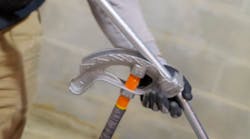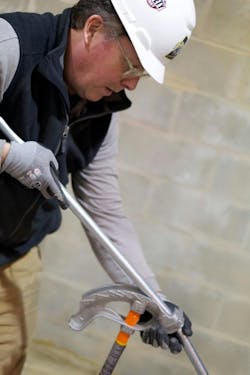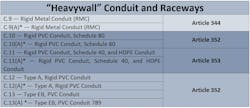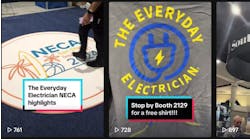Note: This article references the 2017 NEC because the Philadelphia area (the area in which this author works) is still operating under that version of the Code.
As an electrician, no matter what sector of the electrical industry you work in (e.g., residential, commercial, or industrial), the tables found in "Annex C" are a handy reference source or guideline when you are performing basic electrical installations for equipment, devices, and fixtures found in residential houses (i.e., dwelling units), commercial buildings (i.e., special occupancies), and industrial facilities. Neatly tucked away in the rear of the NEC are 12 Informative Annexes, alphabetically arranged A-J that provide additional information for inspectors, electricians, and engineers. Note: The information in this part of the Code book is NOT part of the requirements for NFPA 70; it is included for informational purposes only.
Why you need Annex C
As your responsibilities grow as an apprentice, you may need to determine the number of (single or stranded) conductors for the electrical circuit and the safe or recommended percentage area "inside" the conduit taken up by the circuit conductors/wires. Informative Annex C, which has 26 reference tables, provides a quick and easy reference for conduit fill after you select the type of electrical conduit or raceway for your electrical project. But remember, all the conductors must be the same size and insulation type to use this table.
Navigating the Tables
The tables in Annex C are strategically organized by the schedule or weight of the raceway/conduit — from the lightest to the heaviest. The first eight tables are "thin-wall" raceways or "lightweight" metallic raceways and nonmetallic "light schedule" raceways and lightweight flexible conduits [C.1 through C.4(A)*]. I have included the Article numbers for quick reference in the field in Table 1 below. Note: An asterisk (*) denotes where this table is used in conjunction with Tables C.1 through C.13, the conductors installed must be of the compact type.
The next eight tables contain the lightweight, thin-wall, flexible nonmetallic raceways first and then the heavier (wall or gauge) flexible raceways [C.5 through C.8(A)*]. I have included the Article numbers for quick reference in the field in Table 2 below:
The last 10 tables contain the heavy-weight schedule/heavy wall, metallic raceways first and then the heavier (wall or schedule) nonmetallic raceways [C.9 through C.13(A)*]. I have included the Article numbers for quick reference in the field in Table 3 below:
Annex C tables are typically used for basic installations, short runs of pipe, average conditions, or non-adverse environments. In some cases, the size and number of conductors pulled into a raceway are selected after cross-referencing the tables in Chapter 9 when electricians or engineers are required to perform or apply derating factors such as adjustment factors or ambient temperature corrections factors.
Additional calculations must be performed using the tables in Chapter 9 and other tables in Chapter 3 if the conductors will be installed in a raceway subject to the following:
- More than three circuit conductors.
- The conductors' sizes and insulation types are different.
- Longer than usual conduit runs for branch circuits or feeders.
- Direct sunlight (e.g., harsh weather conditions: extreme heat or cold).
- Harsh environments (bakeries, steel plants, manufacturing facilities).
- Large or very diverse electrical loads that cause excessive heat on circuit conductors.
- Repair, avoid, or identify a problem in an electrical circuit due to malfunctioning equipment.
Sample electrical exam question
Here is an example of a question typically used in an electrical license examination, continuing education course, or journeyman exam related to these concepts:
The maximum number of 8 AWG THW conductors permitted in a 3/4-inch, liquid-tight flexible metallic conduit is _________.
A. 3
B. 4
C. 5
D. 6
Step 1. Locate the appropriate table listed in the directory of Annex C, and identify the "type" of wiring method referenced in the question. Is it light or heavy? Is it a tube conduit or a flexible raceway? I have arranged the type of wiring methods with colored rows in the Tables above to identify them quickly by weight and type. If you use my system, you'll save time and energy.
Step 2. We are selecting Table C.8 — Maximum Number of Conductors or Fixture Wires in Liquid-Tight Flexible Metallic (LFMC).
Step 3. Locate the insulation material type on the conductor in the question from the vertical column on the left side of the table. The question uses "THW" conductors.
Step 4. Locate the vertical column (right next to the insulation type) with the conductor size or (awg) gauge. Our question lists the size to be #8 AWG.
Step 5. Next, you must locate the raceway or conduit size referenced in the question from the row of trade sizes at the top of the table (metric designator). In our question, the trade size is ¾ in.
Step 6. Next, drop down to the insulation type/conductor size and slide over to the raceway size. Where the column and rows meet are the number of conductors recommended to install in this type of conduit or raceway, so (#8 size) THW conductors + ¾ in. LFMC = 5. Bam! Our answer is C.
Follow my column for more tips on applying electric basics concepts in the field, navigating the NEC, preparing for exams, and understanding how to apply Code guidelines in the field. Past columns include Everyday Instructions for Electricians, The Apprentices Guide to Special Equipment, The Apprentice’s Intro Guide to Motors, The Apprentice’s Guide to Service Entrance Cable, The Apprentice’s Guide to NEC Art. 382, The Apprentice’s Guide to Article 625, The Apprentice’s Guide to NEC Art. 550 and The Apprentice’s Guide to Success in the Electrical Construction Industry. For more information on why a structured approach is so important to navigating the NEC and how to put its requirements into practice in real-world settings, read “The NEC for Newbies.”








